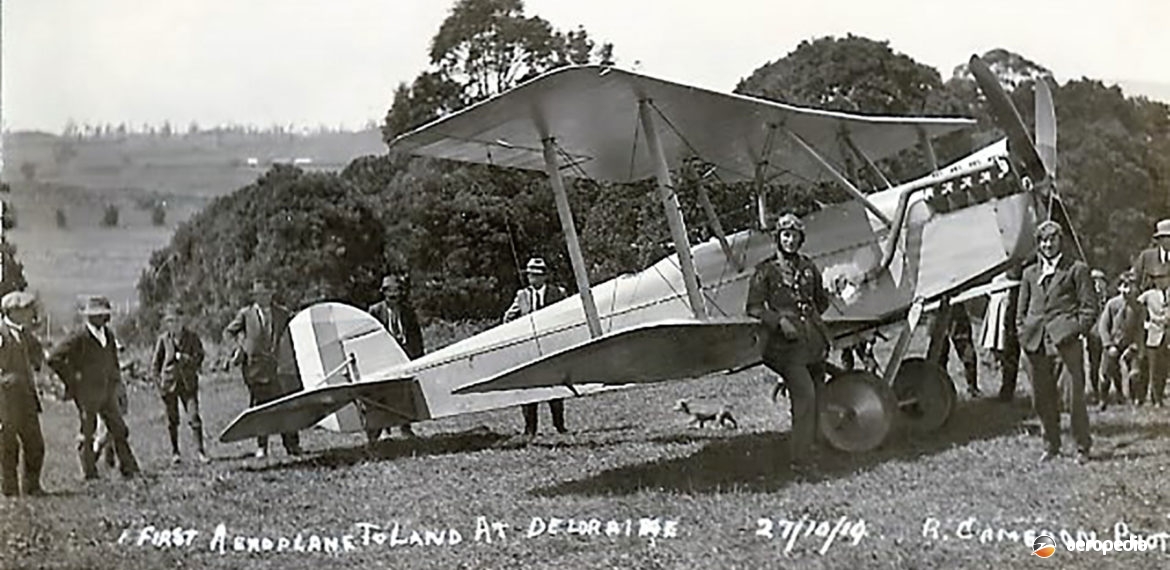Photograph:
Boulton Paul P.9 G-AUCP (c/n P9-7) at Deloraine, TAS in October 1919 (National Archives of Australia A3560,197)
Country of origin:
United Kingdom
Description:
Light commercial transport
Power Plant:
One 67 kw (90 hp) RAF 1A eight-cylinder VEE air-cooled engine
Specifications:
- Wingspan: 8.38 m (27 ft 6 in)
- Length: 7.55 m (24 ft 8 in)
- Wing area: 30 m² (323 sq ft)
- Max speed: 167 km/h (104 mph)
- Cruising speed: 137 km/h (85 mph)
- Initial rate of climb: 198 m/min (650 ft/min)
- Range: 483 km (300 miles)
- Empty weight: 564 kg (1,244 lb)
- Loaded weight: 803 kg (1,770 lb)
History:
Following the cessation of hostilities in World War I, Boulton & Paul Ltd, Riverside Works, Norwich designed a small two-seat wood and fabric biplane known as the P.6, this machine using some parts from the Sopwith Camel in its fuselage, the aircraft being able to be fitted with alternative sets of mainplanes for research into the development of wing sections. The prototype was flown at the Company’s Mousehold aerodrome in Norwich in 1919.
A slightly enlarged variant of this machine was also developed, the prototype of this, the P.9, flying some six weeks after the P.6. This biplane was built to the order of Mr A L Long. It was shipped to Australia, the intention being to use it for patrolling sheep stations in “the Australian outback”. Initially on arrival it was used for delivering newspapers, and on mail flights in Tasmania. It was this machine (G-EAPD) which made the first northbound crossing of Bass Strait when Mr Long inaugurated the Hobart, TAS – Melbourne, VIC service on 16 December 1919 carrying mail. The flight was made via King Island, where the night was spent, continuing on to Torquay, VIC the next day, 17 December.
This machine was never registered in Australia; and it seems it was never allotted a manufacturer’s serial or construction number. Its ultimate fate is not known. However, some believe that this machine was allotted the registration G-AUBT.
On 27 October 1919 Mr A L Long flew his Boulton Paul P.9 from Hobart to Launceston via Deloraine to deliver a bundle of copies of a special edition of his newspaper ‘Mercury’, being accompanied at the time by Mr D K Mckenzie. On 19 November that year he made a survey and photographic flight over the Great Lakes District of Tasmania for the State Hydro Electric Department, a Mr Wilson, Assistant Engineer for the Department being on board to take photographs. On 15 December the P.9 was flown from Launceston to Stanley in northern Tasmania, on the following day leaving at 6.35 am and after a short stop at Torquay arriving in Melbourne at 10.45 am.
Production Boulton Paul P.9s differed from the prototype in having a simplified, strutless tail incidence gear, a different rudder horn balance shape, extra centre-section struts, and a raised decking to permit carriage of freight or passenger’s suitcases.
At least four P.9s were registered in Australia and all were fitted with the 67 kw (90 hp) RAF engine. These were G-AUBT (later VH-UBT – c/n P9-3) registered on 28 June 1921 to Life Insurance Co of Australia Ltd of Melbourne. Ownership was transferred to H O Jolley of Adelaide, SA on 4 November 1922. On 8 November 1922 it hit a car on take-off at Serviceton, VIC, crashed and was written off.
G-AUCP (later VH-UCP – c/n P9-7) was registered on 28 June 1921 to R W Falkiner of Groongal, NSW. It was one of a number of aeroplanes used by this family from its property in the period between World Wars I and II. It was sold to H O Jolley of Melbourne on 7 May 1924, and subsequently was owned by New Era Insurance Co of Australia Ltd of Melbourne; M/s V Collinson of South Yarra; A T Tilt of Malvern; and F C R Jacques trading as Wings Ltd of Melbourne. It crashed at Willaura, VIC on 16 December 1927.
G-AUCT (later VH-UCT – c/n P9-5) was registered on 28 June 1921 to Aviation Ltd of Glenroy, VIC and was operated by C J de Garis. Records indicate it overturned on 9 July 1920 at Glenroy aerodrome near Melbourne and was rebuilt. In April 1922 it was acquired by William Adams & Co Ltd of Melbourne; and later that month by F J Barnes of Hamilton, VIC. Records show it was struck off the register and was then “rebuilt as a monoplane” in June 1922 but its ultimate fate is not known.
G-AUDB (later VH-UDB) had Certificate of Airworthiness No 32 issued on 28 June 1921. It was owned by Messrs C C Matheson and L Bacon who traded as Victorian Flying Service. It crashed at Briagolong, VIC on 6 November 1921 and was destroyed by fire.
It would seem one prototype and seven production machines were built, the prototype and four of the production machines being imported to this region. G-AUCT, which was named ‘Sun Rayse’ was obtained by C J de Garis, as noted above, and he flew in the machine as a passenger when F S Briggs ferried it from Glenroy to make a night landing in Sydney, NSW on 3 July 1920. The same pilot established a series of inter-city records: Mildura to Sydney on 6 July 1920 – 885 km (550 miles) in 6 hrs 10 mins; Sydney to Melbourne on 9 July 1920 – 6 hours 30 mins.
Records indicate that Roby Manuel, an ex-Australian Flying Corps pilot from World War I, took up farming after the war but continued flying, operating a Boulton Paul P.9, supplementing his income with barnstorming work, becoming known as ‘the flying farmer’. He gave interested passengers a 10 minute or 15 miles ride for £1 ($2). He continued flying up to the 1960s, at that time having moved on to operating a de Havilland DH.82 Tiger Moth.

